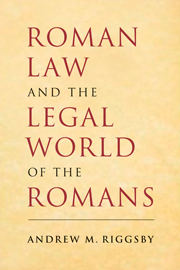Book contents
- Frontmatter
- Contents
- ROMAN LAW AND THE LEGAL WORLD OF THE ROMANS
- 1 Introduction
- 2 Roman History – The Brief Version
- 3 Sources of Roman Law
- 4 Sources for Roman Law
- 5 The Legal Professions
- 6 Legal Education
- 7 Social Control
- 8 Legal (In)equality
- 9 Writing and the Law
- 10 Status
- 11 Civil Procedure
- 12 Contracts
- 13 Ownership and Possession
- 14 Other Rights over Property
- 15 Inheritance
- 16 Women and Property
- 17 Family Law
- 18 Delict
- 19 Crimes and Punishments
- 20 Religious Law
- 21 Law in the Provinces
- 22 Conclusion
- Documents
- Glossary
- Further Reading
- Index
2 - Roman History – The Brief Version
Published online by Cambridge University Press: 05 June 2012
- Frontmatter
- Contents
- ROMAN LAW AND THE LEGAL WORLD OF THE ROMANS
- 1 Introduction
- 2 Roman History – The Brief Version
- 3 Sources of Roman Law
- 4 Sources for Roman Law
- 5 The Legal Professions
- 6 Legal Education
- 7 Social Control
- 8 Legal (In)equality
- 9 Writing and the Law
- 10 Status
- 11 Civil Procedure
- 12 Contracts
- 13 Ownership and Possession
- 14 Other Rights over Property
- 15 Inheritance
- 16 Women and Property
- 17 Family Law
- 18 Delict
- 19 Crimes and Punishments
- 20 Religious Law
- 21 Law in the Provinces
- 22 Conclusion
- Documents
- Glossary
- Further Reading
- Index
Summary
Roman history is usually divided into three periods based on the form of the central government: the “monarchy” or “regal period,” when kings ruled; the “Republic,” a more democratic government; and the “Empire,” when (naturally) emperors ruled. (Note that Rome was an empire [small e] in the sense of “conquering power” centuries before emperors came to the throne. I will use the capitalized “Empire” to refer to the time and form of government.) These divisions are not necessarily as important for the legal system as they are for some other aspects of Roman life, but they do determine where law came from, and give a general background against which to set specifically legal developments. The first three sections of this chapter will give brief explanations of the forms of government that define these three periods. The fourth will mention a slightly different way of dividing things up that is more closely tied to legal history. The final one explains the history of a specific institution that is especially important for Roman law: Roman citizenship.
THE MONARCHY
Roman legend has it that the city was ruled by kings from its founding (in perhaps 753 bc) until a coup which removed not only the last king but the kingship altogether (in 509 bc). Modern scholarship finds these dates (especially the one for the founding) highly suspect, and questions how and even whether the individual events happened.
- Type
- Chapter
- Information
- Roman Law and the Legal World of the Romans , pp. 11 - 24Publisher: Cambridge University PressPrint publication year: 2010



